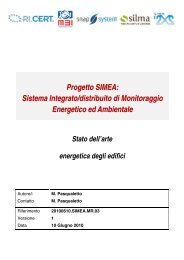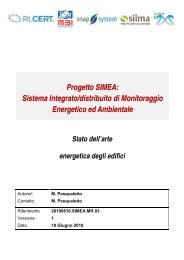Studio di un algoritmo di consensus Newton-Raphson ... - Automatica
Studio di un algoritmo di consensus Newton-Raphson ... - Automatica
Studio di un algoritmo di consensus Newton-Raphson ... - Automatica
Create successful ePaper yourself
Turn your PDF publications into a flip-book with our unique Google optimized e-Paper software.
costo non quadratiche garantisca <strong>un</strong> f<strong>un</strong>zionamento migliore<br />
rispetto alle classiche f<strong>un</strong>zioni costo quadratiche.<br />
A. Algoritmo <strong>di</strong> <strong>Newton</strong>-<strong>Raphson</strong> centralizzato per la ricostruzione<br />
della mappa<br />
Come già anticipato, si utilizzeranno due <strong>di</strong>versi tipi <strong>di</strong><br />
f<strong>un</strong>zione costo. A partire dalla ricostruzione della mappa (37),<br />
presso ciasc<strong>un</strong> agente viene calcolato <strong>un</strong> errore pesato secondo<br />
legge:<br />
• quadratica, qi(a) := 1<br />
2 (yi −G(xi, a)) 2 ;<br />
• iperbolica, hi(a) := β<br />
<br />
yi−G(xi,a) 2<br />
α<br />
+1.<br />
yi è la misura (rumorosa) acquisita dall’i-esimo sensore.<br />
L’<strong>algoritmo</strong> <strong>di</strong> <strong>Newton</strong>-<strong>Raphson</strong> multivariabile è realizzato<br />
con la nota formula<br />
a(n+1) = a(n)−[HF(a(n))] −1 ∇F(a(n)) (39)<br />
dove F(a(n)) è la f<strong>un</strong>zione costo globale (38) valutata<br />
all’istante n e ∇F(a(n)), HF(a(n)) sono rispettivamente<br />
gra<strong>di</strong>ente e matrice Hessiana <strong>di</strong> F(a(n)).<br />
Si vuole vedere come si sviluppa 39 nel nostro caso; ometteremo<br />
la <strong>di</strong>pendenza da n delle <strong>di</strong>verse espressioni trovate,<br />
sapendo che sono tutte riferite alla n-esima iterazione. Non<br />
specifichiamo il tipo <strong>di</strong> f<strong>un</strong>zione costo usata, che denotiamo<br />
con g(·). Al posto <strong>di</strong> g(x), g ′ (x) e g ′′ (x) si sostituiscono i<br />
valori ottenuti con le espressioni (33), (34) e (35) nel caso<br />
iperbolico, o le equivalenti del caso quadratico.<br />
Per calcolare in maniera esplicita F(a), ∇F(a) e HF(a) si<br />
pone:<br />
F(a) = g(z1)+g(z2)+...+g(z3)<br />
zi := yi −G(xi,a) (40)<br />
= g(y1 −G(x1, a))+...+g(yN −G(xN, a))<br />
(41)<br />
dove G(xi, a) è stata definita in (37). Per cui il gra<strong>di</strong>ente<br />
∇F(a(n)) è dato da:<br />
⎡<br />
⎢<br />
⎣<br />
∂F(a)<br />
∂a1<br />
.<br />
.<br />
∂F(a)<br />
∂aM<br />
⎤<br />
⎥<br />
⎦ =<br />
⎡<br />
⎢<br />
⎣<br />
g ′ (z1) ∂z1<br />
∂a1 +...+g′ (zN) ∂zN<br />
∂a1<br />
.<br />
.<br />
che sviluppando si può riscrivere:<br />
⎡<br />
g ′ (z1) ∂z1<br />
∂aM +...+g′ (zN) ∂zN<br />
∂aM<br />
⎢<br />
∇F(a(n)) = −S⎣<br />
avendo posto<br />
⎡<br />
e<br />
⎢<br />
S = ⎢<br />
⎣<br />
−(x1−w1)2<br />
e−(x1−w2)2 .<br />
e−(x1−wM)2 g ′ (z1)<br />
.<br />
g ′ (zN)<br />
⎤<br />
... e−(xN−w1)2 ... e−(xN−w2)2 . .. .<br />
... e−(xN−wM)2 ⎤<br />
⎥<br />
⎦<br />
⎤<br />
⎥<br />
⎦ (42)<br />
⎥<br />
⎦ (43)<br />
(44)<br />
conS ∈ R M×N . Si omettono i calcoli per la matrice Hessiana,<br />
che risulta essere<br />
HF(a) = SG ′′ S T<br />
dove abbiamo in<strong>di</strong>cato con G ′′ la matrice <strong>di</strong>agonale :<br />
(45)<br />
G ′′ ⎡<br />
g<br />
⎢<br />
= ⎣<br />
′′ (z1) ...<br />
. .<br />
.<br />
..<br />
0<br />
.<br />
0 ... g ′′ ⎤<br />
⎥<br />
⎦ (46)<br />
(zN)<br />
Si noti che, dal momento che la formula (39) prevede<br />
l’inversione della matrice Hessiana ad ogni iterazione, nel<br />
momento dell’implementazione si somma ad HF(a) <strong>un</strong>a matrice<br />
<strong>di</strong>agonale δIM , con δ piccolo, per evitare la <strong>di</strong>vergenza<br />
nel caso la matrice Hessiana risulti singolare. L’<strong>algoritmo</strong> ad<br />
ogni iterazione associa a zi il valore delle derivate prima e<br />
seconda della f<strong>un</strong>zione costo g(z), mentre la matriceArimane<br />
invariata e <strong>di</strong>pende solo dalla <strong>di</strong>sposizione spaziale <strong>di</strong> sensori<br />
e ”campane”. In particolare si vede come si potrebbe scegliere<br />
<strong>di</strong> utilizzare delle <strong>di</strong>sposizioni <strong>di</strong> sensori irregolari senza che<br />
l’<strong>algoritmo</strong> si complichi, in quanto basterebbe cambiare i<br />
valori <strong>di</strong> xi, wj che determinano la matrice S.<br />
Algorithm 3 Mapping con <strong>Newton</strong>-<strong>Raphson</strong> centralizzato.<br />
(variabili)<br />
1: a ∈ R M , z ∈ R N , ∇F(·) ∈ R M , HF(·) ∈ R M×M<br />
(parametri)<br />
2: y ∈ R N ⊲ Vettore delle acquisizioni yi S ∈ R M×N ⊲<br />
matrice S definita in (44)<br />
(initializzazione)<br />
3: a = 0<br />
(<strong>algoritmo</strong>)<br />
4: for n = 1,2,... do<br />
5: z(n) = y −S · a(n)<br />
6: for i = 1,2,...,N do<br />
7: g(zi(n)) = ...<br />
8: g ′ (zi(n)) = ...<br />
9: g ′′ (zi(n)) = ...<br />
10: end for<br />
11: ∇F(a(n)) = −S ·g ′ (z(n))<br />
12: HF(a(n)) = ... ⊲ Hessiana definita in (45)<br />
13: a(n+1) = a(n)−[HF(a(n))] −1 ∇F(a(n))<br />
14: end for<br />
Lo schema seguito per il mapping con <strong>un</strong> <strong>algoritmo</strong> <strong>di</strong><br />
<strong>Newton</strong>-<strong>Raphson</strong> centralizzato è riass<strong>un</strong>to in Alg. 3 e risulta<br />
molto conveniente. Infatti, a partire dalle derivate prime e<br />
seconde delle f<strong>un</strong>zioni costo presso ciasc<strong>un</strong> agente, il nuovo<br />
vettore dei coefficienti a(n) viene calcolato in maniera rapida<br />
e con calcoli molto semplici, sfruttando il fatto che la matrice<br />
S rimane costante. Inoltre, supponendo che il calcolo delle<br />
g(zi), g ′ (zi) e g ′′ (zi) avvenga presso ciasc<strong>un</strong> agente, la complessità<br />
totale dei calcoli effettuati dall’intelligenza centrale<br />
<strong>di</strong>pende <strong>un</strong>icamente dal numero <strong>di</strong> campane utilizzate, ovvero<br />
la <strong>di</strong>mensione M della matrice da invertire.

















